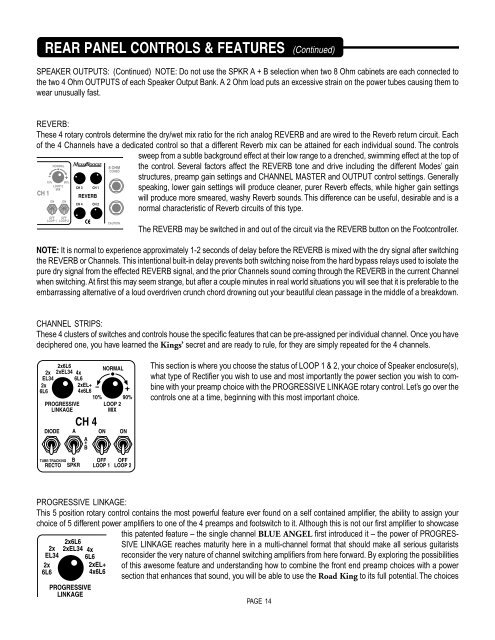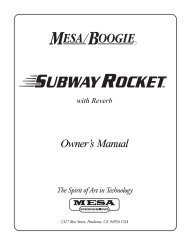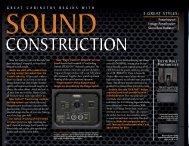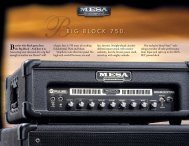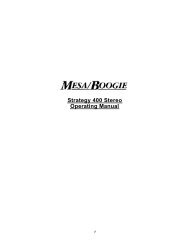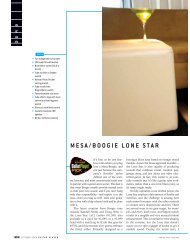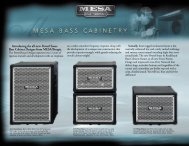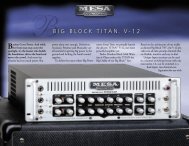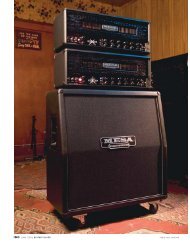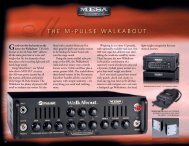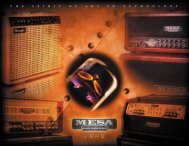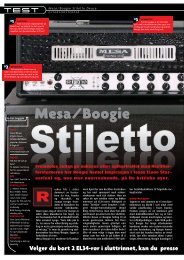Road King Manual - Mesa Boogie
Road King Manual - Mesa Boogie
Road King Manual - Mesa Boogie
- No tags were found...
Create successful ePaper yourself
Turn your PDF publications into a flip-book with our unique Google optimized e-Paper software.
REAR PANEL CONTROLS & FEATURES (Continued)SPEAKER OUTPUTS: (Continued) NOTE: Do not use the SPKR A + B selection when two 8 Ohm cabinets are each connected tothe two 4 Ohm OUTPUTS of each Speaker Output Bank. A 2 Ohm load puts an excessive strain on the power tubes causing them towear unusually fast.REVERB:These 4 rotary controls determine the dry/wet mix ratio for the rich analog REVERB and are wired to the Reverb return circuit. Eachof the 4 Channels have a dedicated control so that a different Reverb mix can be attained for each individual sound. The controlssweep from a subtle background effect at their low range to a drenched, swimming effect at the top ofCH 1NORMAL10% 90%LOOP 2MIXONOFFLOOP 1ONOFFLOOP 2MESA BOOGIECH 3 CH 1REVERBCH 4CH 28 OHMCOMBOCAUTIONthe control. Several factors affect the REVERB tone and drive including the different Modes’ gainstructures, preamp gain settings and CHANNEL MASTER and OUTPUT control settings. Generallyspeaking, lower gain settings will produce cleaner, purer Reverb effects, while higher gain settingswill produce more smeared, washy Reverb sounds. This difference can be useful, desirable and is anormal characteristic of Reverb circuits of this type.The REVERB may be switched in and out of the circuit via the REVERB button on the Footcontroller.NOTE: It is normal to experience approximately 1-2 seconds of delay before the REVERB is mixed with the dry signal after switchingthe REVERB or Channels. This intentional built-in delay prevents both switching noise from the hard bypass relays used to isolate thepure dry signal from the effected REVERB signal, and the prior Channels sound coming through the REVERB in the current Channelwhen switching. At first this may seem strange, but after a couple minutes in real world situations you will see that it is preferable to theembarrassing alternative of a loud overdriven crunch chord drowning out your beautiful clean passage in the middle of a breakdown.CHANNEL STRIPS:These 4 clusters of switches and controls house the specific features that can be pre-assigned per individual channel. Once you havedeciphered one, you have learned the <strong>King</strong>s’ secret and are ready to rule, for they are simply repeated for the 4 channels.2xEL342x6L6PROGRESSIVELINKAGEDIODE2x6L62xEL34 4x6L62xEL+4x6L6ACH 4A +BNORMAL10% 90%LOOP 2MIXONONThis section is where you choose the status of LOOP 1 & 2, your choice of Speaker enclosure(s),what type of Rectifier you wish to use and most importantly the power section you wish to combinewith your preamp choice with the PROGRESSIVE LINKAGE rotary control. Let’s go over thecontrols one at a time, beginning with this most important choice.TUBE-TRACKINGRECTOBSPKROFFLOOP 1OFFLOOP 2PROGRESSIVE LINKAGE:This 5 position rotary control contains the most powerful feature ever found on a self contained amplifier, the ability to assign yourchoice of 5 different power amplifiers to one of the 4 preamps and footswitch to it. Although this is not our first amplifier to showcase2xEL342x6L62x6L62xEL34 4x6L62xEL+4x6L6PROGRESSIVELINKAGEthis patented feature – the single channel BLUE ANGEL first introduced it – the power of PROGRES-SIVE LINKAGE reaches maturity here in a multi-channel format that should make all serious guitaristsreconsider the very nature of channel switching amplifiers from here forward. By exploring the possibilitiesof this awesome feature and understanding how to combine the front end preamp choices with a powersection that enhances that sound, you will be able to use the <strong>Road</strong> <strong>King</strong> to its full potential. The choicesPAGE 14


